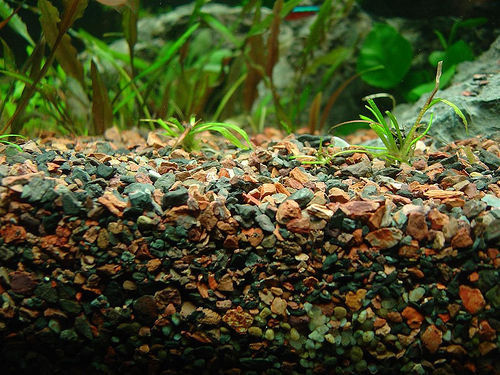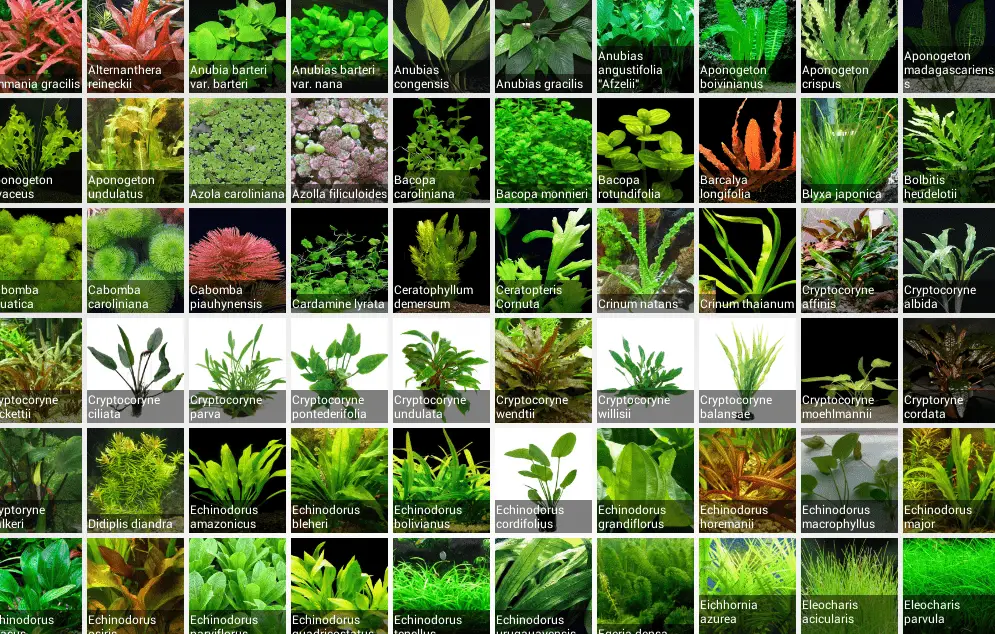Aquascaping is the art of positioning rocks, stones, plants, driftwood, and coral in an aquarium. Aquascaping has become a hobby and craft, with its underwater gardening concept. Most of the time they are inspired by natural environment. Aquascape involves the parameters of design, the knowledge of particular biology, and an awareness of available technology. In this post, we will see how to master Aquascaping.
Large public aquariums often involve aquascaping in their displays. Many public aquariums exhibit wildlife from a particular natural habitat, which makes these biotope aquascapes.
The Goal of Aquascaping?
Jump To
- 1 The Goal of Aquascaping?
- 2 What are The Requirements?
- 3 What Are the Aquascaping Styles
- 4 What Are The Aquascaping Design Elements and Basics
- 5 Aquascaping Tank Light Selection
- 6 Aquascaping Substrate Selection
- 7 Aquascape Fertilizer Selection
- 8 Aquascaping Ornaments Selection
- 9 Aquascaping Plants Selection
- 10
- 11 Aquascaping Set Up, Maintenance, and Testing
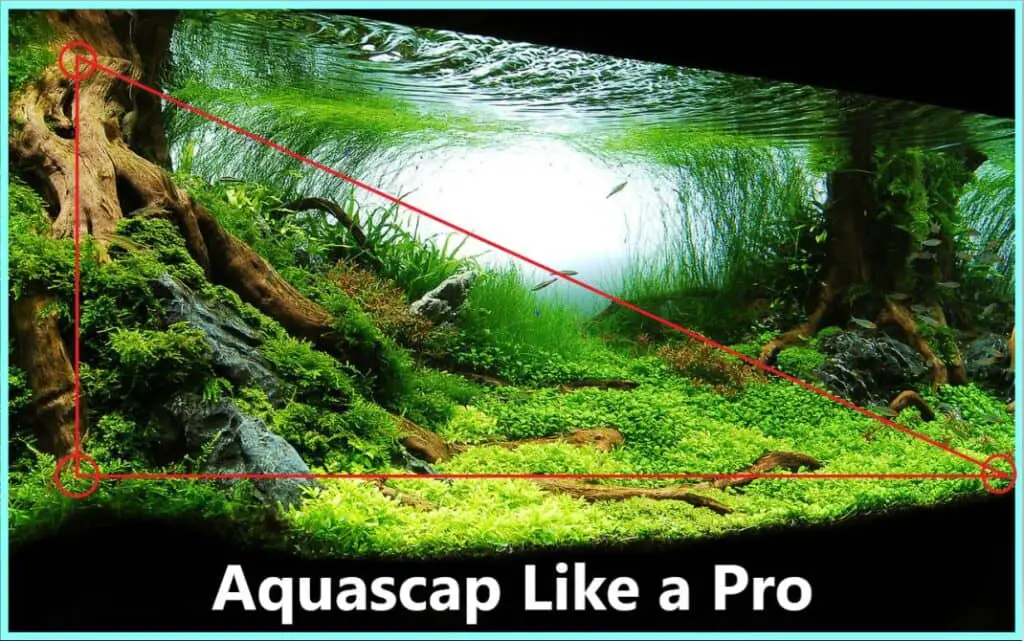
Many replicate underwater scenes and other natural scenes such as deserts, waterfalls, mountains, forests, jungles, etc. While the primary goal of aquascaping is to create a pleasing aesthetic environment, there are numerous aquascaping technical aspects to be considered.
So it is essential to focus on Aquatic plant maintenance, filtration, supporting carbon dioxide levels to sustain underwater photosynthesis, substrate, and fertilization, any fish or other creatures that will be sharing the environment, lighting, and algae management. Aquascapes typically share environments with fish and plants, yet they can also be plants only, plants and rocks, or rocks and no plants.
What are The Requirements?
Furthermore, aquascaping requires knowledge of plants and aquarium basics, including the temperature and lighting requirements of specific plants, water chemistry, substrates, and design principles. This knowledge and experience will allow you to experiment and use more materials and plant types as well as create more complex and stunning aquascapes as you progress. Learning about these requirements of aquarium life, the aquascape styles, and how to plan an aquascape will reduce frustration and help you construct pleasing creations.
What Are the Aquascaping Styles
There are several distinct aquascaping design styles with varying degrees of creating, balancing, and maintenance challenges.
Dutch Style
The Dutch style is a lush array of different kinds of plants rich in leaf colours, sizes, and textures. This style originated in the Netherlands in the 1930s in freshwater aquariums.

Today, Dutch aquascapes are still generally created in freshwater systems because few ornamental plants grow in saltwater aquariums. In this style, we should put plants on varying raised terraces in a linear row fashion of left-to-right known as “Dutch streets.” These often do not include any rocks or driftwood. There are typically smartly trimmed collections of plants that have a feathery foliage. Most of the floor is covered, and tall plants often line the backside.
Most common plants used in this style are, Limnophil aaquatic, Hygrophila, Alternanthera reineckii with red leaves, Ammania gracilis, and Rotala.
Japanese Style
Japanese style aquascaping is known as Iwagumi aquascapes. It belongs to the Nature Aquarium style. Iwagumi means “rock formation” and how these rocks are positioned. The Japanese style or nature aquarium was introduced in the 1990s by Takashi Amano. Takashi Amano set new standards of aquarium creations and management. Amano model aquascapes after intricate Japanese gardening techniques to replicate natural landscapes with a theme of tranquillity and simplicity.

They imitate miniature landscapes with arrangements of asymmetrical groups, including a few species of plants and stones or driftwood. With simplicity in mind, colors are limited, and Iwagumi aquascapes usually have one kind of carpeting plant (glosso, hair grass, or hemianthus callitrichoides.)
Sometimes small leaf plants, such as Eleocharis acicularis, Glossostigm aelatinoides, or Hemianthus callitrichoides. Riccia fluitans, small aquatic ferns, and Java moss(Versicularia dubyana or Taxi- phylum barbieri) use in the tank. A typical iwagumi style is the sanzon iwagumi style. Sanzon stands for “three pillars” in Japanese.
This style uses three stones, with one being noticeably more extensive than the other two. This arrangement symbolizes Buddhism, whereas the central stone is flanked by the smaller ones, sometimes pointing toward the larger stone as if bowing. In Iwagumi we place, the main stone which known as the Oyaishi off-centre, and the Soeishi, or complementary stones, arrange nearby.
Then the secondary rocks known as Fukuseki should place in subordinate spots. The central place of Iwagumi aquascape should place by the asymmetric location of the Oyaishi with ratios that involve Pythagorean tuning. Iwagumi aquascape aquariums with fish typically include only one species. These are schooling fish such as tetras, cardinal tetras, or harlequin rasboras.
It is a bit hard to maintain an Iwagumi aquascape because of the limits of a single plant species and the required light levels. To control high algal growth, we can introduce Amano or other freshwater shrimp species (such as Caridina multidentata and Neocaridina heteropoda) frequently. Iwagumi is not for beginners.
Biotope Style
The definition of bios is ‘life or organism’. Topos is ‘a place.’ So biotope means a place where life lives.
The results of biotope aquascaping can be very aesthetically pleasing. A biotope aquascape strives to imitate the environment of a geographic location.
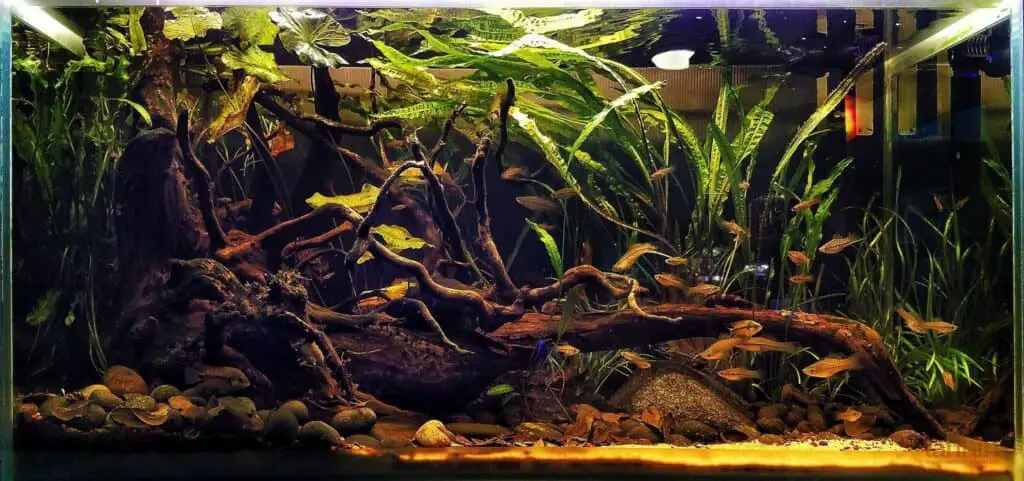
Replicating a natural environment includes knowing the water temperature and hardness, the natural species of plants and fish, and lighting conditions. Having a set of parameters can make balancing life in the aquarium easier and give you and observers a look through a window into a natural setting. The same water conditions (temperature and chemistry), plants and fish species found at the natural locations, and identical gravel or substrate should be used.
This makes the specific requirements of the aquarium well defined. There is no need to research or experiment to determine the compatibility of plants and creatures. Plants and fish do not have to be included, but if they are, they must be the same as what is in the natural habitat. Live aquarium plants are often easier to maintain than a non- planted aquarium as the quality of aeration, filtration, food, and algae management is frequently better.
Jungle Style
The Jungle style is usually densely planted, much like its name. Plants are commonly green foliage, though some have more color. The light shines down from above as happens in the natural environment it mimics. There are often low green plants in the front, and coarser leaf shapes included such as Echinodorus bleheri.
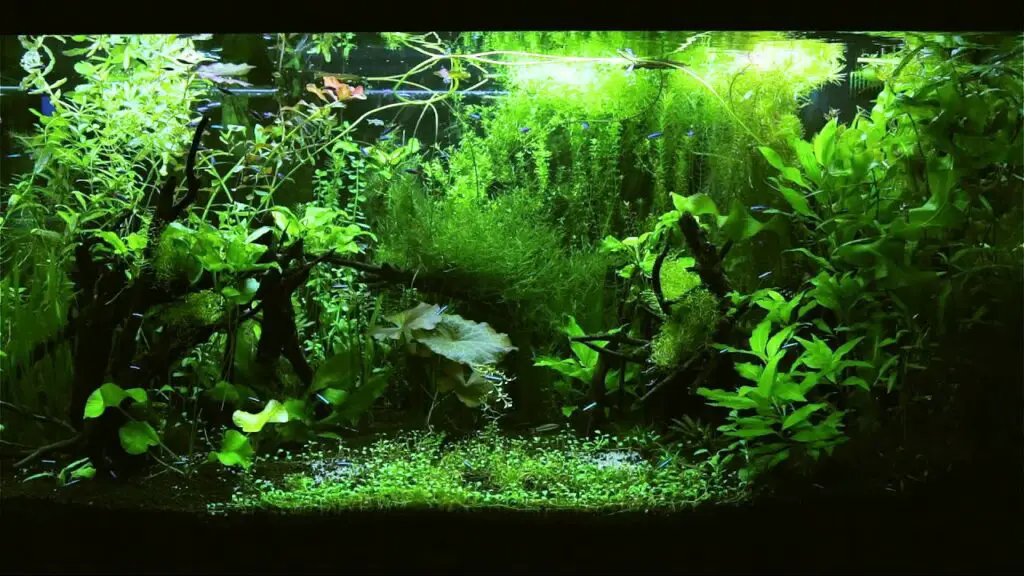
Paludariums Style
A paludarium is an aquascape where a portion of the terrestrial contents such as plants and rocks and other items are above the water while the remainder is submerged. Paludariums are common for aquariums containing amphibians but can support a variety of species, including fish, snakes, frogs, newts, and crabs.

They imitate swamps, flooded forests, beaches, coastlines, islands and river, lake, and pond edges. This style works well for some biotope themes. Some are only partially filled with water. The substrate is built up to form an area that is above the waterline, which allows plants, such as Cyperus alternifolius, Spathiphyllum wallisii, and some bromeliads, to grow with roots immersed under the water. Rocks and wood can also rise above the water’s surface.
Reef Style
Reef style aquascapes are indicative of their label as they replicate natural reefs. While the Dutch and Nature styles are typically freshwater aquariums, the reef style is created in a saltwater system. The Reef style is based on live rock arrangements and often includes corals and additional marine invertebrates along with coralline algae.
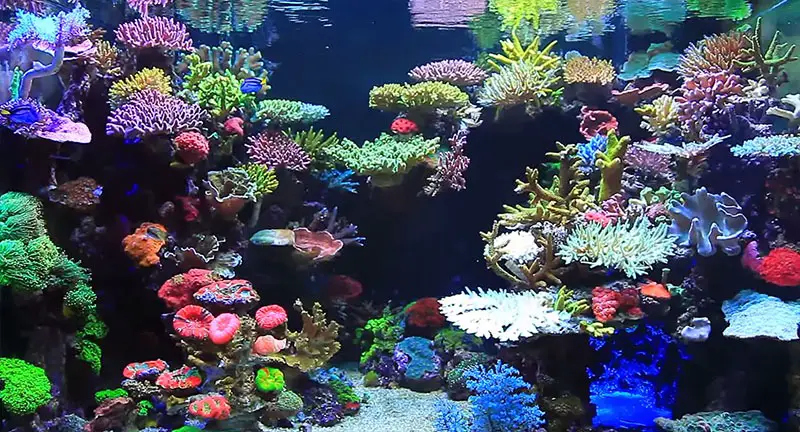
Correct light and CO2 help preferred plants grow and control nutrient levels, to make certain the plants make use of all fertilizer, so there is none to sustain algae. There are ‘aquascapers’ who employ significant equipment for CO2 balance and lighting and filtration, and there are those that curtail the use of technology.
Lighting is a significant factor for the reef style aquascape. Well-designed lighting will not only help show off corals in many shapes and bright colors, but a few that contain symbiotic fluorescent algae-like protozoa called zooxanthellae can be beautifully highlighted. Ultraviolet light aids the health of these invertebrates and enhances the colors these fluorescent microorganisms emit.
Black Water Style
A black water aquascape is a biotope designed to imitate a particular area with murky waters and dead plant matter representing a swamp. Black water aquariums are not as common but can be very attractive in their own right. They often have amber, earthy, warm colors that match other earthen tones of interior design. The secret to a black water aquarium is in the dead leaves, rich soil, and fallen branches. These are a source of tannin. The carbon filter is reduced or not used in the pump.
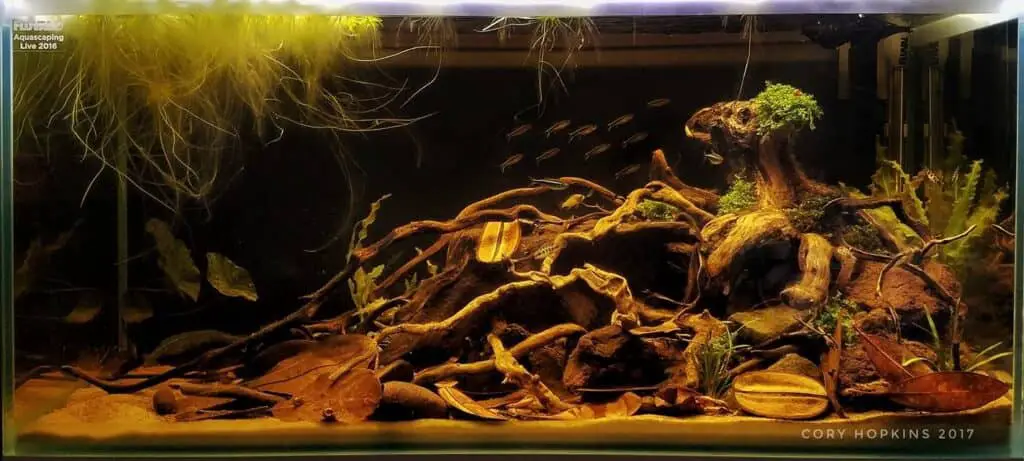
What Are The Aquascaping Design Elements and Basics
Aquascaping does involve your imagination and creativity. However, there are several formulas and theories of design you can use to build an aesthetically pleasing aquascape. As you learn, you can experiment and remove items and start over if you develop a better idea.
Focal Point
The focal point draws the gaze of the viewer first, and then their eyes move to explore the aquascape. A focal point can be a rock, rock formation, particular plant, or a piece of driftwood that draws the attention. There should be only one focal point. The exception is very large tanks.
Every aquascape style should have a focal point. The focal point must be placed correctly according to the Golden Rule of aquascaping.

The Golden Rule(or Ratio) of Aquascaping
The Golden Rule or Ratio of Aquascaping comes from the Greeks. This is the theory that the ratio 1:1.618 is the most pleasing to the human eye. In other words, by making the focal point slightly off-center, rather than in the dead center, you guide the observer’s eyes rather than allowing them to wander back and forth.
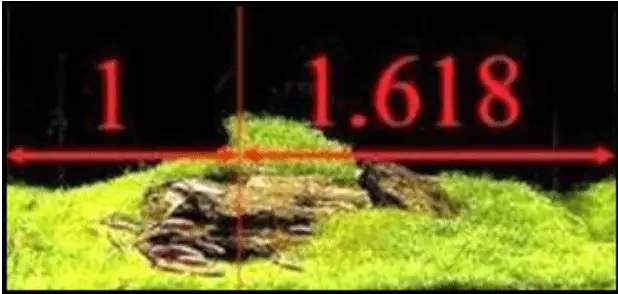
This rule is used in many designs and art forms. Use a tape measure (or ruler) and a calculator and measure the length of the tank from end to end. Divide your results by 2.618. Now use that number to measure from one end of the tank toward the middle. That is where you place your focal point.
Example:
- Your tank is 40 inches wide.
- 40 divided by 2.618 is 15.28 inches.
- Measure 15.28 inches from one side or the other of the tank for determining your focal point.The Rule of Thirds
The “Rule of Thirds” is another method of design theory that derives from the Golden Rule or Ratio, which was discovered by the ancient Greeks. This rule has been applied in every art form for centuries. The rule of thirds shows us how to locate elements in an aquascape that helps direct the eyes. Here is how this works: Imagine your aquascape divided into nine equal parts separated by two equally spaced horizontal lines and two equally-spaced vertical lines, as in the image.
Your significant elements ought to be located either on these lines or at the red-circled intersections. By arranging items with the rule of thirds, we can create appealing and interesting designs; aquascapes that move your viewers’ eyes in a flowing manner revealing beauty with direction. The rule of thirds is another aid to help you establish where to place the focal point and secondary points of interest to create a fascinating viewing experience for your friends, family, and guests.

Foreground, Middle, and Background
Establishing a distinct foreground, middle, and background will help you design. Often, a somewhat gradual transference between these sections is more appealing. Rocks and wood in the middle ground that graduate in height toward the background is appealing. A balance of open space can be dramatic and bring more attention to ornaments, plants, and the overall design.
There is a fine line between simple and boring. Keep things simple and do not overcrowd your tank. However, use a variety such as more than one type of plant to keep from being boring. Too many large leaf plants or large rocks can cause your aquascape to appear smaller.
Avoid Symmetry in Aquascaping
Symmetry is not a goal for aquascape design. Symmetry causes your aquascape to look unnatural or too structured.
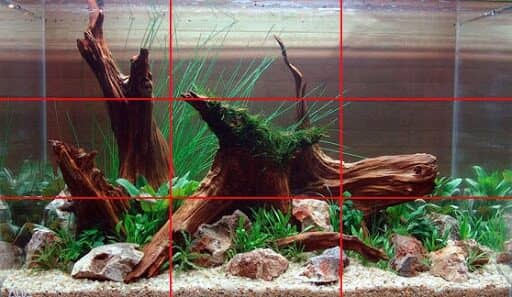
Shape
Filling in your background is not always the best idea. Placing high plants in the background can cause an unnatural ‘hedge’ look. Creating shapes and curves will look much better. There are several design shapes to choose from. A convex shape creates a pleasing aesthetic element. You can use rocks or wood to do this. The concave shape can also look terrific and can be accomplished with rocks, wood, or trimming plants.
A triangular design is often unique and appealing. Island design is fun and can look very interesting.
Mountain’ Scapes’
There are several useful tips for creating mountains:
- Use the Golden Ratio for locating your mountain in your scene.
- Plants in the foreground should be low to the ground.
- Make the beginning third of your mountain from the ground very steep or even vertical.
- Be consistent with one type of rock to create mountains.
- Pile substrate at the base to create the natural appearance of the mountain rising from the floor.

Planting with Design in Mind
When planting, start with the background plants first and work forward. Place plants densely with stems in the substrate at about an inch apart. Moss can be tied to objects such as rock or wood for an optimum result but used sparingly because most will grow fast.
Particular plant types into different areas. Different textured and varied green shades of plants add depth and interest to the look. Colorful plants such as red and orange can add to your scheme, but consider whether locations will be competing with your focal point. These are some plants you can use for the aquarium Carpet Plants for Freshwater Aquascapes
Pygmy Chain Sword – Pygmy chain sword is popular and resembles common grass which is brilliant for imitating lawns or land.
Hairgrass- Hairgrass is close to Pygmy Sword, although thinner and more delicate and tends to move with the water.
Dwarf Baby Tears – Dwarf baby tears are small and stay that way. They lend themselves to imaginative uses such as even treetops.
Java Moss – Java moss is very delicate and looks like mold. When grown on wood, this can resemble and mimic a tree.
Marsilea Minuta- Marsila Minuta has a vibrant green color that looks like clover.

Aquascaping Tank Light Selection
Choosing light for your aquascape involves much more than aesthetic appeal. Aquarium lights are not only for your viewing pleasure; they provide live plants and corals with illumination to manufacture their food.
Plants, corals, and other inhabitants depend on lighting to produce food. Too much light can offset the balance of your environment and cause algae growth, and too little light can cause the demise of living plants and creatures. Even the most basic aquarium kits usually include lights and a tank hood. The lights included might or might not be appropriate for your plan.
The tank hood is for preventing water from evaporating, keeping dust and foreign items out of the water, and for housing lights. The right lighting system will help you control the amount of light your habitat receives and for how long each day.
Light Timers
Many types of light generate heat and can cause your water temperature to get too high and cook the inhabitants. Leaving lights on too long every day can promote algae growth.
The lights in your tank should usually mimic the natural environment and, in most cases, this is six to twelve hours a day. A lighting system with a timer will help you maintain the correct light exposure. A light timer gives you one less thing to remember each day. Many tank hoods have either built-in lights with timers or separate power cords for timer additions.
Fish and other inhabitants also appreciate the cycle of light and dark. There are hoods that incorporate several types of lighting such as an actinic (blue light) bulb, a full spectrum bulb, and a moonlight. A timer can be used to schedule each light simulating the lighting during dawn and twilight periods. A moonlight with a desirable effect can be scheduled for the night.

Types of Lighting
There are many types of fish tank lighting available. The type of light you need depends on your tank type and inhabitants. Freshwater and saltwater tanks that only contain fish can often get by with regular fluorescent lights. That is not true for most tanks that contain live aquascapes whether freshwater or saltwater.
Light types include:
- Fluorescent Lights
- Compact Fluorescent Lights
- High Output (HP) or T5-HO Fluorescent
- High Output (VHO) Fluorescent
- Light Emitting Diodes (LED)
- Metal Halide Lights
Aquarium Light Spectrum
The spectrum of visible light is expressed in nano meters (nm). A nano meter is equal to one billionth of a meter and references the wavelength of light in an aquarium. Varying wavelengths generate different colors. Our eyes can only see the light from 380 nm (violet) to 780 nm (red).
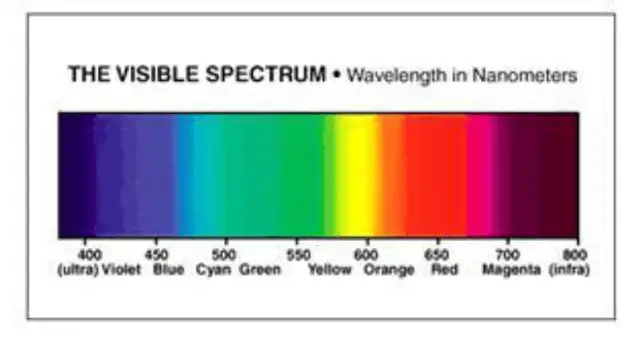
Regular Fluorescent Light
Basic fluorescent lights are the inexpensive ones that come with most starter aquariums. They normally range from 15 to 40 watts with Kelvin ratings from 3,000° to 10,000°. (The Kelvin scale measures the color temperature.)
Compact Fluorescent Light Bulb
The compact is the next level up of fluorescent lights. They range from 10 to 100 watts with Kelvin ratings from 5,000° to 10,000°. These lights are brighter and more intense. These compact lights should only be used with special fans and vented hoods due to the amount of heat they produce.
High Output (HP) or T5-HO Fluorescent Light
HO Fluorescent lights range from 20-60 watts with Kelvin ratings from 6,000° to 11,000°. They last longer and cost more than the basic fluorescent lights that come with the starter aquariums. These lights use a T5 light fixture, and they frequently include built-in fans that keep bulbs working at the most favorable levels. T5-HO lights supply an abundance of light and are cooler than metal halides.
T5 fluorescent lights are smaller and brighter than the T8 fluorescents. T5-HO lights help grow some of the most demanding SPS corals when placed in the center to upper regions of the aquarium. They give off even lighting, which is good for plant health.
Very High Output (VHO) Fluorescent Light
VHO Fluorescent lights are not as popular as the other types and range from 75 to 160 watts with Kelvin ratings from 10,000° to 20,000° They are more costly and produce a great deal of heat, so the fixtures have built-in fans. The fans are some- times not enough to keep water from overheating and require an aquarium chiller. You need a ballast or a specific fixture made for VHO lights.
Metal Halide Light
Metal Halide lamps range from 175 to1000 watts with Kelvin ratings from 5,000° to 20,000°. They are very bright and the most comparable to the sun in terms of luminosity but can become very hot and need fan cooling. Larger tanks do better with Halides.
LED Aquarium Light
Light-emitting diodes (LEDs) make light by converting electric current. LEDs are more efficient than standard incandescent bulbs: According to the U.S. Department of Energy, a typical Energy Star-rated LED uses 20 to 25 percent of the energy that an incandescent bulb uses; the LED lasts up to 25 times longer.
LED lights are pricey but offer several distinct advantages over other types of lights. The advantages of LED lights over traditional fluorescent and metal halide lights include:
- Much longer life span
- Cooler operation
- Less energy consumption
- No filament to break
- Flexibility in configurations due to the small size
Better LED fixtures to let you customize colors and light intensity on programmed schedules. Moonlights are generally LED lights.
Freshwater Aquarium Light – Fish Only
Low-watt Fluorescent lights between 18 and 40 watts work well for aquascapes with no live plants.
Freshwater Aquarium Plant Lighting
Choosing a freshwater plant lighting system is dependent on the:
- size and depth of the tank
- types of plants
- growth rate desired
A common measurement is two to five watts per aquarium gallon. Know how many gallons your tank holds, the light wattage, and how much light your specific plants require.
Saltwater Aquarium Light – Fish Only
Saltwater tanks supporting only fish are fine with regular Fluorescent bulbs. A full spectrum light is desirable with a bulb of 6,000 K and an actinic (blue light) bulb. If you want coralline algae to grow, some grow better with more actinic lighting and low phosphate levels.
Saltwater Reef Aquarium Light
Lighting a saltwater tank can be the most expensive investment at start-up and will add to the electric bill and require buying replacement bulbs in the future. Saltwater reef tanks that contain corals and other life forms that need light to require high output (HP), very high output (VHO) fluorescent, metal halide lamps, or a combination of all.
These lighting systems often create enough heat to warrant the need for an aquarium chiller. A common recommendation for reef tanks is between 4 and 10 watts per tank gallon though you need to learn the light requirements for each species you are considering. Most of the coral utilize zooxanthellae and photosynthesis to supply food. Some corals are also filter feeders, but this is usually less of a contributor to their nutritional needs.
For soft coral, use power compacts when aquarium depth is 24 inches deep or less. If you have large stony coral, use HO or VHO fluorescents. For small stony coral, use T5-HO Fluorescents or Metal Halides. Metal halides are a good choice, although they heat the water. The T5-HO lights produce less heat and are less costly.
Keep in mind that the deeper you go in the water, the less light penetrates, so locating corals higher in your aquascape will get them additional light.
Bulbs and Tubes
Choosing the right bulbs is imperative for optimum coral, plant health, and aesthetics. A Kelvin is a measurement of temperature. Your goal should be 6500 kelvin (about what the sun is) or more. 10,000 kelvins produces a nice white glow. Less than 6000 kelvins causes an unwanted yellowish tint and anything above 10,000 kelvins has no further effect on coral or plant growth.
T5-HO emitting between 7,000 kelvins and 10,000 kelvins is the optimum spectrum while metal halides aim for 10,000 kelvins. The light a bulb generates can be measured in lumens. The electrical power that supplies the light bulb is measured in watts.
Plants and light
There are some general signs that your plants might have problems related to light:
- Low crouched growth can be caused by too much blue in the light spectrum.
- Tall, gangling plants can be caused by too much red in the light spectrum.
- Stunted growth usually means too much green and yellow in the light spectrum.
When plants are not getting enough light symptoms can include pale green or yellowish color instead of bright or dark green, weak stems, few leaves growing, and better growth on plants near the light source. However, diatom algae is also a sign that the daily light period is too short; lights are ageing and have lost spectrum; floating or other plants are blocking light, or light levels are too low.
Electrical Safety
Most of us have heard since childhood that electricity and water do not mix and can be fatal. This is a constant consideration with aquariums. Always turn off and unplug all electrical appliances before making contact with the water. That means do not stick your hands in the water unless all electrical systems are off and unplugged.
Not much current is needed to cause an electrical shock. Only 10 milliamps can cause pain, and anything over 50 milliamps can kill you. A heater can be drawing 800 milliamps. A core balance earth leakage circuit breaker (ELCB) can be installed in some wiring systems to monitor the current and break the circuit, should a short or fault occur.
In the United States and Canada, these are commonly known as a Ground Fault Circuit Interrupter (GFCI), Ground Fault Interrupter (GFI), or an Appliance Leakage Current Interrupter (ALCI). In the United Kingdom, these devices are referred to as RCD or an RCBO. Non-residual-current circuit protection devices are called Circuit Breakers or MCBs and are sometimes called trips or trip switches.
In Australia, the devices are known as safety switches or RCD. However, all of them are designed to break the circuit when the current loss exceeds a certain point. This cut-off point range is from 10 milliamps to 30 milliamps, and 30 milliamps are suitable for an aquarium.
Aquascaping Substrate Selection
The substrate is the foundation of your aquascape. You want to get this right from the beginning as replacing a substrate usually means complete disassembly of your tank. Learn what nutrients your choice of plants will need to decide on a substrate as plants feed on the roots.
There are plants that require specific substrates. The symptoms of the wrong substrate will often not show immediately but can destroy your aquascape.
A substrate designed for saltwater tanks can release salts and minerals into the water that can imbalance pH levels and be fatal to some freshwater plants and inhabitants such as Discus and some Asian fish, as well as a variety of plants including moss, Fissidens, and floating plants. The substrate helps anchor and provides nutrients for your plants. Live aquarium plants improve the quality of aeration, filtration, nutrients, algae management, and the health of inhabitants.
Because the substrate is feeding your plants, you need to choose one that is rich in macronutrients. Plants suffering from deficiencies can discolor and die. You can help supplement your plant diet with specific fertilizers, but they can cause other imbalances, and you cannot make up for a deficient substrate.
A substrate is best when three to eight millimeters per grain. Substrate grain that is too small can suffocate plant roots. A substrate that is too large can reduce root contact. Also, consider all other live residents of your aquascape when considering substrates. Read the labels on the substrate packaging.
Substrates Examples:
ADA Aquasoil
Excellent for plants but can lower pH balance.
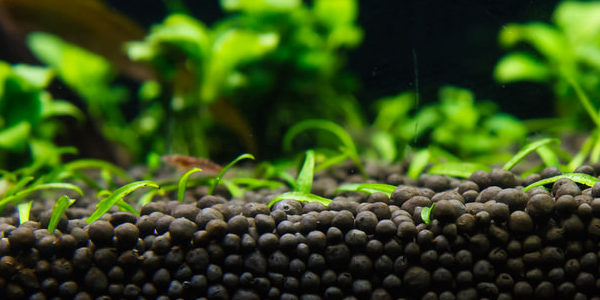
Clay
Clay is great as a bottom layer substrate for specific plants though can be difficult to work with and is not recommended for beginners.

Plain Gravel
This is not a good choice unless at least half of the total volume is a nutrient-rich supplement or soil.
Fluorite/Seachem
Excellent sources of nutrients for plants.
Soil
Soil is an excellent choice and inexpensive. Avoid any soil that contains fertilizers or phosphates that could be harmful to your aquarium. Commercial substrates such as Eco-Complete or Up Aqua work well. As with all substrates, find out how they affect water or pH balance and plants. There are also additives in tab or pellet form that is placed close to the roots of plants that work.
Aquarium Sand
There is a variety of aquarium sands available including live sand and dry sand. Consider the grain size of any sand, for if the grain is too small harmful gasses can be trapped in the substrate. Grains that are too large can collect detritus. A grain size from 1 mm to 2 mm is recommended.
“Live sand” promoters tout that is living beneficial bacteria are in the sand, which is questionable.
Sand must be cleaned before use. A five-gallon bucket filled up to halfway with the sand and then with tap water is a great way to clean sand. By stirring the sand the lighter impurities and dirt will rise and can be drained. You may need to repeat this process several times until the water is no longer visibly dirty or too cloudy. A shallow sand bed under 2 inches deep or a deep sand bed over 4 inches deep will help prevent algae growth on the sand bed.
If you use a shallow sand bed, including live rock, can aid in nitrogen balance. When your sand bed is in place, let your aquascape settle for 24 hours or more.

Read more Can You Put Metal Objects In A Fish Tank|10 Tips You Must Know
Aquascape Fertilizer Selection
Liquid Fertilizers
There are two main groups of fertilizers; macronutrients and micronutrients.
Macronutrients
This group includes nitrogen, potassium, and phosphorous, and is generally found in water with fish. If your aquascape contains numerous plants, you will need to add macronutrients.
Micronutrients
These include iron Boron, Calcium, Chloride, Copper, Iron, Magnesium, Manganese, Molybdenum, Sulfur, and Zinc. These are found in commercial fertilizers. Certain plants might need an additional iron supplement.
Seachem Flourish and NPK
These products are effective, but costly.
Homemade
Some websites and guides suggest making fertilizers. If you choose to make your own, research all ingredients and nutrients as well as the quantities to prevent harming any other tank inhabitants.
PMDD(Poor Man’s Daily Drops)
A Sears and Cronin recipe that works. You can make this quickly and for little cost. You can also buy the dry mix.
Iron
As mentioned, an iron additive will help plants stay healthy and colorful. The lighting and CO2 are factors in determining the quantities of fertilizer needed.
Aquascaping Ornaments Selection
Ornaments are the wood and rocks in your aquascape. Many hobbyists consider the ornaments to be the heart of the aquascape.
Wood
Appealing wood usually has branches or twigs that attract and direct the eyes. Wood can have a dramatic effect on your scene, and it is an element that can spark your imagination and creativity. Wood that seems to climb your aquascape with interesting bends is desirable. You can intertwine these with plants and moss as well.
Wood can rise up from the bottom as if it was once growing or come down from the top as if the branch fell from a shoreline. Wood can be placed so that some is submerged while the rest is above the surface Be certain to boil any wood you find before placing the piece in your tank. If you purchase wood, always wash the piece before using it to remove any chemicals that could have been used for wood treatment.
You might find a perfect piece of wood that will not stay where you want. The wood might be too buoyant and float to the top. The wood might need to soak in water and become saturated first. Soaking wood (outside your tank) will help remove the natural tannins that can offset pH balance.
There are woods that saturate quickly, such as the popular aquarium wood Manzanita. Some pieces might need to be weighed or tied down. If you use any silicone to hold pieces together, make sure it is non-toxic.
Read more How To Get Driftwood To Sink? [SOLVED] Easy Way
Read more Is It Safe To Put Dried Bamboo In An Aquarium?
Read more Put Lucky Bamboo In Aquarium? Is Bamboo Safe For Fish?
Rocks
Rocks are another element for the creative venture in aquascaping. Rocks of natural colors are preferred, and of course, those that are naturally found in the location a biotope is imitating are a must.
Earth tone rocks such as black, grey, and browns usually look best. Any rock you choose must stand up to being submerged in water. A rock that crumbles causes disorder in your scene. Make sure all loose particles and dirt have been removed from rocks first. Use a stiff brush to scrub rocks and let them soak overnight in a bucket or sink.
Shale
Shale can contain a high content of organic matter which can release hydrocarbons (petroleum) into the water. This will cause an oily scum to appear on your water’s surface. Any rock that will affect the environment of your aquascape negatively should be avoided.

Limestone
Carbonate rocks such as limestone can increase the pH and hardness of your water. However, limestone does not seem to significantly increase pH. So while carbonate rocks can upset pH, they are not always a danger – depending on what else you have in your tank. For example, the African Rift Lake Cichlid benefits from the pH. Check your pH weekly if you use any carbonate rocks.

Carbonate Rocks
There is a quick test for identifying carbonate rocks called the ‘acid test’. Some people use vinegar for this test by dropping some on the rock and checking for bubbles or fizz. Bubbles present are a positive sign of carbonate rock. However, vinegar is a weak acid and will not determine the status of all rocks. You need diluted hydrochloric acid, for accurate results. Do not make contact with hydrochloric or muriatic acid. Protect yourself with gloves, long sleeves and pants, and safety glasses or goggles.

Pyrite or Fool’s Gold
Pyrite should be avoided in aquascapes and any aquariums because of its strong acidifying effect, possible dangerous heavy metal content, and the acidifying effect it can have on water, causing heavy metals to be toxic. Pyrite resembles gold, hence the name ‘fool’s gold.’ Pyrite has a yellow shiny metallic luster with crystals and often sharp edges.
Pyrite can be contained within other rocks and appears as spots or streaks on the surface.

Avoid Rocks With Heavy Metals
Heavy metals (lead, zinc, copper, cadmium, iron, and so on) are toxic for fish, inverts, and people. Some rocks can inject heavy-metal pollutants into your water. The chances are slim, but there are ways to make those changes even less. If you collect rocks, then review the area where they come from.
Avoid rocks from old mining areas or landfills as well as downstream from mines or landfills. Also, avoid areas where heavy manufacturing or chemical manufacturing is occurring or has taken place. Metals are mostly dangerous to fish only when in a free ionic state in the water. Water conditioners ‘detoxify’ heavy metals by binding them with compounds that fish cannot take in. Heavy metals are often locked in these compounds and rendered inert.
However, acidic water (with a pH of lower than 7) can activate dangerous metals. Iron is the most common metal present in nature as rust. This iron oxide can sometimes be seen on rocks. This is usually not an issue unless there is enough iron oxide that the water begins to discolor with a rusty tint.
Generally Safe Rocks
- Crystalline Quartz (Rock Crystal, Amethyst, Citrine, Rose Quartz, Smokey Quartz).
- Granite
- Microcrystalline Quartz (Jasper, Agate, and Sard)
- Jade
- Petrified wood
- Onyx Black rock
- Slate
- Quartz
Unsafe or Caution Rocks
- Coal
- Dolomite
- Limestone
- Sandstone
- Carbonate rocks
- Pyrite or Fool’s Gold
Read more Can I Use Outdoor Gravel Or Rocks In an Aquarium? How To Use Them
Live Rock
Aquascaping with live rock in a saltwater environment adds to aesthetic appeal and the health of marine life. Live rock can help filtrate the water in your tank. Rock can also be utilized to obscure heaters, pumps, and other equipment. Place rock with the aquascape goals of optimizing filtration, maintaining a functional and safe environment for the inhabitants, and satisfying your aesthetic vision.
Rock is a natural item, usually in a natural state and shape. Open-type structures are desirable to allow for water movement around the rocks, help keep rocks free of detritus build-up, and provide any fish with hiding spots. Fish seek hiding areas to feel secure which reduces any stress.
Become familiar with the types of rock available and their appearance, color, shapes, sizes, and weights in order to visualize your design. This will make choosing rock easier, and you will have a better chance of achieving your vision. You can create stacks, overhangs, pillars, crests, peaks, and caves. Emulating nature scenes will usually be the most visually appealing.
Review natural pictures of rock formations on land and underwater to get ideas. Plan the foundations for your rock structures. Rocks can rest on the substrate, the floor of your tank or be built up with underwater epoxy.

Be careful about placing rocks on top of some substrates as certain fish burrow and can cause rocks to move and or fall. You can bind rocks together with ties, underwater epoxy, or use gravity to stack them. Keep in mind the environment is wet and fluid so rocks can slide or fall. Falling rock can injure fish, damage plants, and even crack or break the glass.
Using the sides of your tank to support a rock structure is not recommended. This reduces the benefit of filtration and can cause glass damage. Rocks can be flat on the aquarium bottom to replicate a reef or piled to resemble upper reef slopes. They can also be stacked high at the back of the tank to mimic reef walls or slopes. Rock with little or no coralline algae works well as base rock for your structure’s foundation.
Rock that is covered with coralline can be attractive and often shows better at the higher levels of your arrangement. Coralline rocks should be placed where they will receive light. Generally, you can use up to one and a half pounds of rock per gallon of water. Of course, this varies with the sizes, shapes, and types of rock you use.
Do not overdo rock in your aquarium and allow adequate room for water movement, filtration, and fish as well as other residents. Using more than one type of rock can make your scene more interesting and introduce additional beneficial bacteria into the environment.
Sort rock into three categories:
Flat Rocks: These rocks can be used as cliffs, bridge pieces, slopes, or walls.
Support or Leg Rocks: These rocks can support other rocks.
Larger Bulky Rocks: These rocks can serve as legs or supports, bridge pieces, faces, slopes, or mountains.
You can also incorporate coral into your rock structures. Because corals need different amounts of light and water movement, the design ought to allow for this. Take into consideration that different types of corals have specific light needs and that some corals should not be placed in contact with other types of corals as they can sting one another.
Aquascaping Plants Selection
Any fish inhabitants appreciate freshwater aquarium plants. Place them according to the design elements discussed earlier. Aquascaping with live freshwater aquarium plants requires additional effort but can open a new world to your creative juices. Many plants can be trimmed for the desired shape. To increase the odds of your success, choose hardy species to gain the experience of placing and caring for freshwater aquarium plants.
There are a few common types of freshwater aquarium plants:
- They are floating plants such as Fairy Moss and Riccia, which can provide shelter for young fish.
- Rhizomes have thick stems with leaves at the top. They root in the substrate and grow across the substrate surface.
- The rosette-style plant grows fast and can quickly cover the substrate.
- A stem plant roots in the substrate and is available in a variety of colors and types.
- Java Moss is great for freshwater aquariums that can grow in a range of water parameters and pH with low light requirements.
- Water wisteria is great for beginners. This plant grows fast and helps control algae by eradicating nitrates from the water.
- Anubias nana is a heardy plant that usually grows in most water parameters that can flower and grows out of the water as well.
- Amazon Sword is an easy species to grow and also helps maintain algae.
Growing Healthy Plants
Photosynthesis is how plants convert hydrogen, oxygen, and carbon molecules into the basic sugars which create energy and food for plants. Chlorophyll is a blend of two pigments, chlorophyll and chlorophyll B, which enable the process of photosynthesis to occur.
Additional aquarium plant pigments are present; such as the orange pigment carotene or the yellow pigment xanthophylls, although these pigments are not part of the photosynthesis process. When plants are not getting adequate light, an unhealthy yellow color appears because there is a decrease in the green pigment of chlorophyll. This can frequently be the result of an iron deficiency.
We are exposing chlorophyll to light results in photosynthesis. As we learned in the previous chapter on lighting, photosynthesis, and respiration are the two processes that occur in plants needed for healthy plants to break down nutrients and grow.
These processes occur during the phases of the cycle of light and dark. When photosynthesis has taken place, during respiration plants will receive oxygen as well as create heat energy and carbon dioxide. During the dark period, they respire CO2 in the aquarium, and higher concentrations of CO2 and light will boost the action of chlorophyll.
Your aquascape must mimic the amount of light and dark naturally required by the plants. Depending on where a specific plant species evolved, a specific light or darkness period will be optimal. Sometimes, depending on the number of plants and fish, your aquascape might need carbon dioxide supplementation.
You can use a soda bottle filled with yeast, warm water, and sugar. Connect that to an airstone in the tank or a pressurized CO2 tank that instills a predetermined quantity of carbon dioxide. Research the needs of any plants you choose. If you select different species, make sure they have compatible requirements. In a biotope aquarium, the plants share the same geographical location and environment, so this is easier.
Live aquarium plants help aeration, filtration, as well as food and algae, control for healthier inhabitants. There are aquarium-safe fertilizers that come in liquid or tablet form. Some substrates contain laterite, which also provides nutrients.
Aquascaping Set Up, Maintenance, and Testing
Setting up and maintaining an aquascape can be intimidating for beginners. While the process is complex, knowledge will instill confidence and increase your chances of success.
Sump Setup
A sump is a separate tank that gets water from a gravity overflow in your aquarium. Water rises over the top of the overflow and into a pipe to the sump. A return pump sends the water back to the tank. The aquarium sump can hide unsightly equipment, increase the total water volume, and make changing water easier. Saltwater supplements can be put into the sump to dissolve before going into your tank.
Refugium Setup
The refugium is a separate tank used to extract nitrates, phosphates, carbon dioxide, and other nutrients from the water by “harvesting” the macroalgae. Macroalgae also support many advantageous life forms like amphipods and copepods that can feed fish and corals. Refugiums usually require a light source and a deep sand bed.
Filters
There are hobbyists who use mechanical filters, such as a power filter or canister filter, and those who use only protein skimmers. The mechanical filters are optional and can also only be used at certain times, such as when there is algae growth.
A protein skimmer works well to remove the majority of most organics. However, a power filter is not always needed. Mechanical filters require regular cleaning every few days to prevent nitrate issues.
Protein Skimmer
A protein skimmer can be used as a standalone, hang on the side of the tank, or used in a sump. Protein skimmers are not always required for a saltwater reef tank. Performing regular water changes can be done in place of using a protein skimmer for aquariums, with few inhabitants if you are experienced.
When curing live rock and using a protein skimmer, keep an eye on the collection cup. This might fill up quickly in the beginning.
Starting Your System
Once you have everything in place, turn your system on and let it run for a few days and up to a week. Test the water daily for any ammonia or nitrites.
When there are none, but you can perceive small amounts of nitrates, your water is ready for inhabitants. Live rock can be so good at de-nitrification that your water might not get a nitrate reading.
Quarantine Period
Add inhabitants to your aquarium slowly and be certain to use a quarantine tank. While this adds a step to the process, this is cheap insurance. Since you likely pay for fish and coral, this will help ensure your inhabitants survive as well as protect your investment. All fish and corals should remain in a quarantine tank for several weeks to be observed for signs of infection such as saltwater fish disease.
Be prepared to treat them immediately. A quarantine tank gives fish a chance to distress from transport and an opportunity for you to observe and inspect them. Since corals can also transmit diseases, you would be wise to dip them in Lugol’s Solution (concentrated iodine) for 10 – 15 minutes before placing them in a quarantine tank.
You can also get pest dips to prevent things like montipora eating nudibranchs, acropora, or flatworms.
Activated Carbon
Carbon helps remove dissolved nutrients and smells as well as clean aquarium water. Activated carbon must be replaced accordingly; how often depends on your tank situation. Activated carbon comes in a variety of grades. Some are better at leeching compounds, and others release phosphates into the water. A reef tank can benefit from activated carbon since they also help solve algae issues.
Be careful when changing a large amount of activated carbon in your tank. This can shock your corals and replace one-third to one-half at a time.
Aquascaping Tank Setup
Selecting a location for your aquarium involves several considerations from light to weight Because, A location that gets direct sunlight could be good or bad, depending on your inhabitants. Generally, direct sunlight is not good as this can heat up your tank water and disrupt any special light cycles. Water in aquariums weighs from 8 to 12 pounds per gallon.
A 100-gallon tank could weigh over 1,000 pounds so you need to know the capability of the floor and structure where you will place the tank. If you have any questions, consult an engineer or other professional. Also, consider the consequences of a leak and what damage the total amount of water in your tank could do.
If you live on an upper floor of an apartment, for instance, other people could be affected. Check with your insurance agent to see what you are covered for. Consider how much room you need around the tank for maintenance and comfortable viewing. Placing your tank where maintenance is difficult can make you regret your hobby and even neglect your tank.
Reef Tank Setup Equipment Needed:
- Aquarium
- Lights
- Light Timer
- Salt Mix
- Sand
- Live Rock
- Protein Skimmer
- Power Filter (optional)
- Algae Scraper
- Sump and/or Refugium (optional)
- Quarantine Tank
- Power heads (multiple)
- Food
- Thermometer
- Heater
- Test Kits (chlorine, pH, ammonia, nitrite, nitrate, phosphate, calcium, alkalinity, iodine)
- Reverse Osmosis filter (optional)
- Hydrometer or refractometer
- 2 Clean Five Gallon Buckets
- Fish, Corals, and other Invertebrates
- Macro Algae such as chaetomorpha or gracilaria for use in the refugium
Test for Leaks
Make sure your aquarium is level and fill your tank at the chosen location while watching for leaks. However, If you use any type of hose to fill your tank, do not use high pressure and be careful not to tap the glass with a metal hose end or attachment. Aquarium glass can break easier than most people assume.
Make sure to use dechlorinated tap water or reverse osmosis water. However, for saltwater setups, add the premeasured salt mix when the tank is about two-thirds full. Turn on powerheads to keep the water flowing. After several hours, test the specific gravity with a hydrometer. This should be in the range of 1.023 – 1.025. If the specific gravity is too high, you can remove some of the tank water and add fresh water only. If the specific gravity is too low, then add more salt mix.

